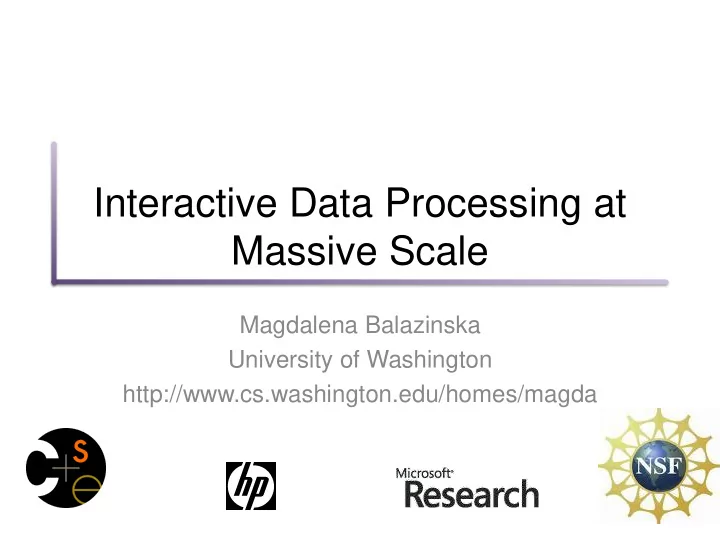

Interactive Data Processing at Massive Scale Magdalena Balazinska University of Washington http://www.cs.washington.edu/homes/magda
Nuage Project • Science is becoming a data management problem • Existing database management systems are insufficient – Wrong data model, wrong features, insufficient scalability • Nuage project goals (http://nuage.cs.washington.edu/) – Focus on scientific applications – Massive-scale parallel query processing – Cloud computing: DBMS as a service for science • Current collaborators/applications: Astronomy Oceanography Jeff Gardner Bill Howe, UW eScience Andrew Connolly
Astronomy Simulation Use Case • Evolution of large scale structure in the universe – Universe is a set of particles (gas, dark matter, stars) – Particles interact through gravity and hydrodynamics – Output snapshot every few simulation timesteps Simulation No. Particles Snapshot Size Few dozen to few hundred dbtest128g 4.2 million 169MB snapshots per run cosmo50 33.6 million 1.4 GB cosmo25 916.8 million 36 GB • Analysis needs: – Select-project-join (SPJ) queries over snapshot data – Data clustering within snapshot – SPJ and recursive queries over clustered data
Astronomy Simulation Use Case • Implemented SPJ queries over raw data – Relational DBMS (single site and distributed) – Pig/Hadoop – IDL: State-of-the-art in astronomy
Friends-of-Friends Clustering • Efficient clustering algorithm • Implemented in Pig/Hadoop and Dryad/DryadLINQ Best total runtime was 70 min
Problem Statement • Given magnitude of data and queries • Need more than efficient query processing • Users need tools for managing queries at runtime: – Accurate, time-based progress indicators – The ability to see representative partial results – The ability to suspend and resume queries – Intra-query fault-tolerance – Agile query scheduling and resource management • All this without too much runtime overhead
Parallax: Progress Indicator for Parallel Queries • Accurate time-remaining estimates for parallel queries • Why is accurate progress important? – Users need to plan their time – Users need to know when to stop queries • Implementation: MapReduce DAGs in Pig – Pig scripts that translate into MapReduce DAGs
Accuracy is a Challenge Query: Script1 from Pig tutorial Translates into 5 MR jobs Perfect estimate Input data: 5X excite search log 210 MB of data Pig estimate
Parallax Approach MapReduce job instrumentation: Map Task Expected processing speed Tuples remaining Slowdown factor For all pipelines in all jobs Parallelism accounting for skew and variations
Experimental Results Script 1 + UDF - Serial Script 1 - Serial 8 nodes, 32 maps, 32 reduces, zipf 8 nodes, 32 maps, 17 reduces, uniform
Problem Statement • Given magnitude of data and queries • Need more than efficient query processing • Users need tools for managing queries at runtime: – Accurate, time-based progress indicators – The ability to see representative partial results – The ability to suspend and resume queries – Intra-query fault-tolerance – Agile query scheduling and resource management • All this without too much runtime overhead
Intra-Query Fault Tolerance • Existing intra-query fault-tolerance methods are limited – Parallel DBMSs restart queries when failures occur – MapReduce-style systems materialize all intermediate results – Result: either high-runtime overhead or costly failure recovery! • FTOpt: We have developed a fault-tolerance optimizer – Automatically picks the best fault-tolerance strategy per operator None Materialize Checkpoint
Problem Statement • Given magnitude of data and queries • Need more than efficient query processing • Users need tools for managing queries at runtime: – Accurate, time-based progress indicators – The ability to see representative partial results – The ability to suspend and resume queries – Intra-query fault-tolerance – Agile query scheduling and resource management • All this without too much runtime overhead
Nuage Project • Nuage project goals (http://nuage.cs.washington.edu/) – Massive-scale parallel query processing – With focus on scientific applications – Cloud computing: DBMS as a service for science
DBMS As a Service for Science • SciFlex: A Cross-scale Cross-domain Scientific Data Management Service – Schema recommendation & data upload utilities – Query, archive, and visualization services – Data intensive computing! – Data, schema, and tool sharing + tool recommendation – Annotations, tagging, disagreement, discussions – Security: need to share safely – SLAs for science • Interesting systems issues involved in building SciFlex • In collaboration with Microsoft Research
Conclusion • Sciences are increasingly data rich • Need efficient, large-scale query processing • Need other data management services too • Nuage/SciFlex project strives to address these needs
Acknowledgments • Students: Nodira Khoussainova, YongChul Kwon, Kristi Morton, Emad Soroush, and Prasang Upadhyaya • Collaborators: Jeff Gardner, Dan Grossman, Bill Howe, Dan Suciu, and the SciDB team
Acknowledgments • This research is partially supported by – NSF CAREER award IIS-0845397 – NSF CRI grant CNS-0454425 – An HP Labs Innovation Research Award – Gifts from Microsoft Research – Balazinska's Microsoft Research Faculty Fellowship
Recommend
More recommend